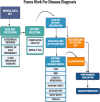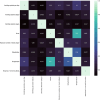A retrospective study using machine learning to develop predictive model to identify rotavirus-associated acute gastroenteritis in children
- PMID: 40247842
- PMCID: PMC12005185
- DOI: 10.7717/peerj.19025
A retrospective study using machine learning to develop predictive model to identify rotavirus-associated acute gastroenteritis in children
Abstract
Background: Rotavirus is the leading cause of severe dehydrating diarrhea in children under 5 years worldwide. Timely diagnosis is critical, but access to confirmatory testing is limited in hospital settings. Machine learning (ML) models have shown promising potential in supporting symptom-based diagnosis of several diseases in resource-limited settings.
Objectives: This study aims to develop a machine-learning predictive model integrated with multiple sources of clinical parameters specific to rotavirus infection without relying on laboratory tests.
Methods: A clinical dataset of 509 children was collected in collaboration with the Regional Institute of Medical Sciences, Imphal, India. The clinical symptoms included diarrhea and its duration, number of stool episodes per day, fever, vomiting and its duration, number of vomiting episodes per day, temperature and dehydration. Correlation analysis is performed to check the feature-feature and feature-outcome collinearity. Feature selection using ANOVA F test is carried out to find the feature importance values and finally obtain the reduced feature subset. Seven supervised learning models were tested and compared viz., support vector machine (SVM), K-nearest neighbor (KNN), naive Bayes (NB), logistic regression (Log_R) , random forest (RF), decision tree (DT), and XGBoost (XGB). A comparison of the performances of the seven models using the classification results obtained. The performance of the models was evaluated based on accuracy, precision, recall, specificity, F1 score, macro F1, F2, and receiver operator characteristic curve.
Results: The seven ML models were exhaustively experimented on our dataset and compared based on eight evaluation scores which are accuracy, precision, recall, specificity, F1 score, F2 score, macro F1 score, and AUC values computed. We observed that when the seven ML models were applied, RF performed the best with an accuracy of 81.4%, F1 score of 86.9%, macro F1-score of 77.3%, F2 score of 86.5% and area under the curve (AUC) of 89%.
Conclusions: The machine learning models can contribute to predicting symptom-based diagnosis of rotavirus-associated acute gastroenteritis in children, especially in resource-limited settings. Further validation of the models using a large dataset is needed for predicting pediatric diarrheic populations with optimum sensitivity and specificity.
Keywords: Child health; Disease diagnosis; Gastroenteritis; Machine learning; Rotavirus; Supervised learning.
©2025 Paul et al.
Conflict of interest statement
The authors declare there are no competing interests.
Figures




Similar articles
-
Prediction and feature selection of low birth weight using machine learning algorithms.J Health Popul Nutr. 2024 Oct 12;43(1):157. doi: 10.1186/s41043-024-00647-8. J Health Popul Nutr. 2024. PMID: 39396025 Free PMC article.
-
[Construction of a predictive model for in-hospital mortality of sepsis patients in intensive care unit based on machine learning].Zhonghua Wei Zhong Bing Ji Jiu Yi Xue. 2023 Jul;35(7):696-701. doi: 10.3760/cma.j.cn121430-20221219-01104. Zhonghua Wei Zhong Bing Ji Jiu Yi Xue. 2023. PMID: 37545445 Chinese.
-
Multimodality radiomics prediction of radiotherapy-induced the early proctitis and cystitis in rectal cancer patients: a machine learning study.Biomed Phys Eng Express. 2023 Dec 20;10(1). doi: 10.1088/2057-1976/ad0f3e. Biomed Phys Eng Express. 2023. PMID: 37995359
-
Artificial intelligence in clinical care amidst COVID-19 pandemic: A systematic review.Comput Struct Biotechnol J. 2021;19:2833-2850. doi: 10.1016/j.csbj.2021.05.010. Epub 2021 May 7. Comput Struct Biotechnol J. 2021. PMID: 34025952 Free PMC article. Review.
-
Evaluating Binary Classifiers for Cardiovascular Disease Prediction: Enhancing Early Diagnostic Capabilities.J Cardiovasc Dev Dis. 2024 Dec 9;11(12):396. doi: 10.3390/jcdd11120396. J Cardiovasc Dev Dis. 2024. PMID: 39728286 Free PMC article. Review.
References
-
- Aliabadi N, Tate JE, Haynes AK, Parashar UD, Centers for Disease Control and Prevention (CDC) Sustained decrease in laboratory detection of rotavirus after implementation of routine vaccination—United States, 2000–2014. MMWR. Morbidity and Mortality Weekly Report. 2015;64(13):337–342. - PMC - PubMed
-
- Ambrish G, Bharathi G, Anitha G, Chetana S, Dhanraj, Kiran M. Logistic regression technique for prediction of cardiovascular disease. Global Transitions Proceedings. 2022;3(1):127–130. doi: 10.1016/j.gltp.2022.04.008. - DOI
-
- Binka FN, Anto FK, Oduro AR, Awini EA, Nazzar AK, Armah GE, Asmah RH, Hall AJ, Cutts F, Alexander N, Brown D, Green J, Gray J, Iturriza-Gómara M, Navrongo Rotavirus Research Group Incidence and risk factors of paediatric rotavirus diarrhoea in northern Ghana. Tropical Medicine & International Health. 2003;8(9):840–846. doi: 10.1046/j.1365-3156.2003.01097.x. - DOI - PubMed
MeSH terms
LinkOut - more resources
Full Text Sources
Medical
Miscellaneous

